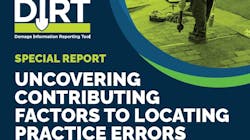How to Reduce Underground Utility Damage: CGA
Three cases studies compiled and analyzed by Common Ground Alliance reveal root causes of some underground utility damage. The group identified locating practices as a contributor to more than one-third of all underground utility damage. The case studies and analysis are included in “Uncovering Contributing Factors to Locating Practice Errors.”
“Three snapshots across different stakeholder groups all show the power of a consensus-based approach to reducing underground utility damage,” said Sarah Magruder Lyle, president/CEO, in a statement. “We’re seeing a massive investment in the infrastructure that forms the foundation of our day-to-day lives. Stakeholders simply must improve coordination to protect both our communities and our investments in public utilities.”
More on underground infrastructure
- How to handle challenges of BEAD, the Broadband Equity Access and Deployment Program
- USIC partners with excavators on safe digging for underground infrastructure
- Pepco rolls out a comprehensive inspection program to safely assess more than 60,000 manholes and vaults in the nation’s capital.
- Infrastructure spending will continue to drive strong construction
Locating error case studies
The contributors and topics covered in the report are:
- Google Fiber’s efforts to coordinate with 811 centers, locators, and fiber-installation sub-contractors on large fiber and network build projects. This study looks at steps taken in 10 states to reduce over-notification, reduce project delays, and improve efficiencies for all involved stakeholders.
In its analysis, CGA noted that $42.5 billion in federal spending on broadband infrastructure will put “additional strain on the already overloaded [811 Centers] system” at a projected annual growth rate of 15% to 20% in location requests. - The Massachusetts Department of Public Utilities’ (MA DPU) proactive enforcement on facility operators that were failing to complete markouts on time. As an alternative to monetary penalties, the MA DPU had operators develop corrective action programs to address the underlying issues.
The report noted a 10% improvement in on-time locating as a result of “improved communication between involved stakeholders.” The communication efforts uncovered underlying issues such as lack of communication with locating staff and excavators. - North Carolina 811’s (NC811) analysis of the effects of ticket screening. This study examines tickets that were initially “cleared,” but then re-issued because the excavator found evidence of unmarked facilities at the work site, and how many of those tickets were associated with DIRT-reported damages.
About the Author
Rod Sutton
Sutton has served as the editorial lead of Construction Equipment magazine and ConstructionEquipment.com since 2001.
Our mission is to help managers of heavy equipment and trucks to improve their performance in acquiring and managing their fleets. One way we do that is with our Executive Institute, where experts share information and ideas that will enable equipment managers to accurately manage equipment costs so that they can deliver the optimum financial benefits to their organizations.
We also have a laser focus on product development, performance, and technology; as well as equipment acquisition, disposal, and maintenance. Our exclusive Field Tests take earthmoving equipment and truck into the field for professional evaluations.
Check out our free newsletters to see the latest content.
You can find Sutton on LinkedIn.

